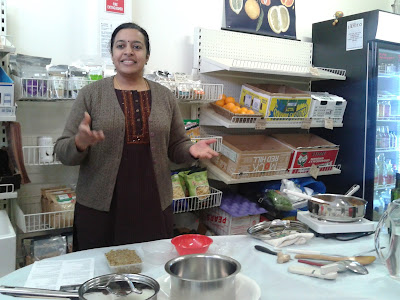Fast forward 20 years and I am trekking in Nepal with my husband. We are on the Annapurna circuit and the only thing we feel safe eating for most of the 25 day trek is dhal bhat, a tasty and filling combination of potato and chickpea curry and rice. We would eat it for lunch and dinner sitting in teahouses or out on rooftop terraces watching the wind blowing the snow off the top of the mountains surrounding us.
That seems so long ago.
Now I am a mother, increasingly interested in healthy eating and so attending an Indian vegetarian cooking class held in a small organic shop in Seaford. The shop is called New Harvest Produce and is one of a number of small quality organic shops I happily notice popping up all over the place. The course is jokingly called "Nice dhal, Darl!" as this is what the shop owner's father says to her mother whenever she cooks dhal.
Teaching the class is Malini Jayaganesh, whose business card says Food Writer and Cookery Presenter, but who also works full time in IT. She is originally from Kerala, an area in Southern India and speaks about food being a time capsule of family traditions, a way to connect with your culture and a method of maintaining health and well-being by following Ayurvedic principles. Malini is calm and friendly and although she is going to cook 4 different types of dhal for us in under 2 hours, she never seems hurried or flustered.
We are given a sheet of paper containing recipes she learnt from her grandmother and aunts, featuring West Coast Dhal, Himalayan Dhal, South-East Coast Dhal and Desert Dhal. This is to highlight the variety of different cultures and cuisines found within India.
Malini has pre-prepared a tray containing 17 different containers of legumes foraged from her pantry. She says that she is running a bit low by Indian standards.
The tray is passed around and I am invited to inspect the beans closely. Malini discusses some of the less commonly used beans like Kala Channa- black chickpeas which are great for diabetics and Adzuki beans, which will be used in the West Coast Dhal.
We begin by talking a bit about dhal. A combination of legumes and other vegetables, it is an inexpensive form of protein and a wholesome, stomach-filling meal. Vegetarians need to include a variety of legumes in their diet to ensure they consume the full spectrum of essential amino acids their bodies would otherwise get from meat. Malini says that her family has been vegetarian for 700 years and that her grandmother would cook particular meals based on the cycle of the moon to ensure the necessary variety in the family's diet.
Cooking dhal must always begin with soaking the beans overnight (although red lentils can be just boiled for quick preparation) and the soaking water MUST BE DISCARDED before rinsing and then cooking the lentils in boiling water. When the beans are ready, discard the cooking water also. This is because there is a substance under the skin of the beans that causes gas and indigestion.
To cook the general rule is to add 1 cup of beans to 4 cups of water, bring to the boil and then simmer for about 40 minutes. Malini has pre-cooked all of the beans for our recipes and says that they can also be frozen in portions at this point.
The cooking begins with Desert Dhal, from Rajasthan in Northern India. This uses mung beans and is cooked with capsicum, mushrooms and an amazing blend of spices. The shop sells a spice blend which has the most tantalizing aroma and is well worth the investment.
When this is ready it is taken out the back and served to us on little plates with a slice of millet bread. It is fantastic! And I am not even too keen on capsicum or mushrooms!
We then move on to West Cost Dhal, which uses adzuki beans, pumpkin, zucchini, yellow button squash and coconut cream.
Next comes the more complicated Himalayan Dhal, which uses 17 different ingredients and calls for the curry to be made from scratch.
This is the spicy chickpea and potato curry I ate in Nepal, it smells wonderful when it is cooking and is whisked out the back of the shop when ready so that we can complete the course by cooking South-East Coast Dhal.
This includes leafy greens such as kale and bok choy, is made with red lentils, coconut and mustard seeds. It is delicious and apparently goes quite well with fish.
The Himalayan Dhal is brought out and as soon as I taste it, I am transported back to the mountains. It is lovely.
I had a great time at the "Nice dhal, Darl!" course and if you are in Melbourne I would recommend keeping an eye out for future courses held at New Harvest Produce.
I will include some of these dhal recipes in future posts, but for now, some golden rules to remember when cooking dhal:
* Always soak the beans overnight and discard the soaking water.
* Rinse thoroughly before adding the cooking water.
* The beans can be frozen in meal-sized portions once cooked, so you don't have to plan so far in advance every time you make dhal.
* Dhal always tastes better the longer it has to sit, so let it settle on the stove for a bit before serving and in the unlikely event that there is any left over, eat it for lunch the next day :)










No comments:
Post a Comment